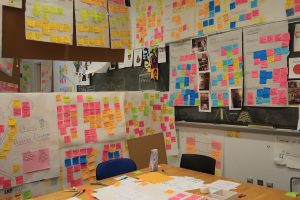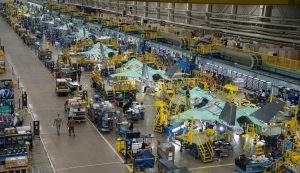After the MIT/Olin Colloquium late April, I took the chance to learn more about the highly praised teaching and learning method at Olin College. Its keywords are integrated learning in context, design thinking and intrinsic motivation. At Olin the students develop a broad view of innovation, about feasibility (engineering and science), viability (economics and business), and desirability (psychology, humanities, arts).
“A traditional approach to higher education may be actually preventing us from producing innovators!”
(Quote Olin College President Miller).
Olin College
With about 350 students, Olin College is small in size but large in impact. “Learning things that matter; learning in context; learning in teams. Envisioning what has never been and doing whatever it takes to make it happen. Do that 20 times and you will be employable forever,” says Richard Miller, President of Olin College of Engineering. In Ruth Graham’s report “Global State of Engineering Education” Olin is cited for its “multidisciplinary student-centered education that extends across and beyond traditional engineering disciplines and is anchored in issues of ethics and social responsibility.”

We were immersed in the Olin College educational environment in a one of their classrooms (private photo)
Think of Olin as a lab school and a professional learning center. It’s education is not only different, it is also intended to be an education laboratory. Enthusiast students guided us over the campus and showed us the learning spaces. We saw the students highly engaged in one of the 25-35 design-build projects they conduct ($55,000 company funding per team).
Olin begins with hands-on challenges from day one, and it culminates with a two-semester Corporate Capstone project (SCOPE) where teams engaged on impact projects with corporate partners, government research labs, NGO, and startups. “21st century Innovators require more than specialized knowledge! No amount of emphasis on narrow specialized courses will produce the innovators we need,” says Miller. Education for the innovation economy is not just about knowledge and skills, argues Miller. It’s about mindsets, collaborative, interdisciplinary, ethical, empathetic, entrepreneurial and global.
No need for a complete Engineering Body of Knowledge?
Students told us that Olin education is education in the post-Google era. What replaces narrow, specialized courses? Miller advocates for more global, complex, multidisciplinary challenges. It is important to learn the basic fundamentals of engineering sciences on a need-to-know basis rather than a full framework of maths, physics and engineering sciences. It is more important to learn how to build upon the fundamentals, how to ask the right questions and acquire van validate new knowledge from the abundance of information that is available on the internet, from YouTube to Instagram to online courses on the EdX platform.
Many Olin graduates end up in start-ups and project management careers. They are recognized for their creativity, teamwork and risk taking.
Almost all classes are project-based, not only academically interesting, always adding value to companies, organisations or communities. The feedback culture is very strong, and the small scale of the programmes make freeriding not an option. The educational programmes are very human-centred, with high customer involvement, lots of collaboration, empathy and talking.
Integrated learning in context
During the campus tour I was immersed in Olin’s teaching and learning methods for just an hour. I learnt that visual thinking, discussing and debating have a prominent place, and that all learning spaces easily facilitate this approach.

Creative learning spaces at Olin College (private photo)
Quantitative engineering analysis on your own alternates with reviewing a number of random assignments of other people to check if you understand the concepts involved, reflect on your own work, learn to give feedback, get inspired by the work of others, and together get the big picture by writing on the whiteboard what key concepts you feel comfortable with, and which remain confusing.
I was also confronted by their introductory approach of a design solving process of an engineering problem. Collaboratively finding out what choices have to be made when and why. Learning how to decompose big fuzzy questions into more concrete sub-questions that each admit one or more strategies for answering them. Then work in groups on the whiteboard to create a question decomposition map, and then take the time to decide together what strategies should be pursued and in what order. The most important things we learned in that hour? Asking the right questions to each other!
Mindsets
At Olin College:
Education = Knowledge + Skills + Mindsets
- Collaborative Mindset
- Interdisciplinary Mindset
- Ethical and Empathetic Mindset
- Entrepreneurial Mindset
- Global Mindset
- Growth Mindset (Dweck, Stanford)
- Grit (Duckworth, U Penn)
Lockheed-Martin
After the immersion at Olin College, I continued my trip to Fort Worth. At Lockheed Martin I met the supervisors of our Delft interns and had a visit to the impressive F-35 assembly line. Brief discussions with quality assurance staff and leaders in the innovation department struck me, because within just a few minutes, each of these discussions resulted in concerns about the readiness level of young graduates of higher engineering schools and universities for their job.
“In the near future talent, more than capital,
will be the limiting factor”

The final assembly line of the F35 (photo Lockheed Martin)
The industrial experts and leaders in innovation found the knowledge and skills of most graduates not broad enough. “Many young graduates who enter our workforce after their study at a university have a good theoretical understanding of the fundamentals, but little idea how business works and what engineering practice is about”.
Even more striking was their fear about the readiness of the new generation of graduates for the digital transformation that is taking place at an enormous pace in their hi-tech company. More and more engineering work involves sensor technology, connecting things, data and analytics, digital system management, networked manufacturing, network programmability, system security, etcetera. The experts expressed serious concerns that many technical universities all over the globe run the risk to completely miss the fourth industrial revolution in their education, while this is expected to have a massive impact on the engineering profession.
Prepare for the 4th Industrial Revolution
My final destination was a keynote for the Mechanical Engineering Industrial Board of a private research university in Dallas. Also here the main topics of discussion between management and the Industrial Board were how to assure high-quality and relevant education for an age of accelerating change, in which the labour market and the engineering profession will change radically. Faculty management discussed the development of new courses on vision-based sensor technology, bio-instrumentation, 3D printing, and machine learning.
Agile enough?
Can we changing fast enough? Is the academic staff equipped and capable to transform the education as we know it? Are we ready for “Flexication” (Flexible Education)? Are universities prepared to put more emphasis on innovation, and less on fundamental research? These were just a couple of questions that were stuck in my mind during my flight home, after an intensive week overseas of colloquia at MIT, the immersion in a different educational approach at Olin College, brief meetings with industrial leaders and experts at Lockheed Martin, and a discussion in an industrial board in Dallas.



